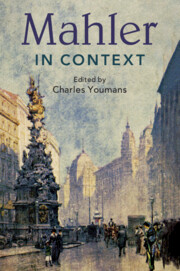Book contents
- Mahler in Context
- Composers in Context
- Mahler in Context
- Copyright page
- Dedication
- Contents
- Figures
- Music Examples
- Notes on Contributors
- Preface and Acknowledgments
- Abbreviations
- Part I Formation
- Part II Performance
- Part III Creation
- Chapter 12 The Composer “Goes to Press”
- Chapter 13 Mahler and Program Music
- Chapter 14 Intertextuality in Mahler
- Chapter 15 The Symphony, 1870–1911
- Chapter 16 Mahler and the Visual Arts of His Time
- Chapter 17 Mahler and Modernism
- Chapter 18 Reception in Vienna
- Chapter 19 Mahler’s Press from London to Los Angeles
- Part IV Mind, Body, Spirit
- Part V Influence
- Further Reading
- Index
Chapter 16 - Mahler and the Visual Arts of His Time
from Part III - Creation
Published online by Cambridge University Press: 18 December 2020
- Mahler in Context
- Composers in Context
- Mahler in Context
- Copyright page
- Dedication
- Contents
- Figures
- Music Examples
- Notes on Contributors
- Preface and Acknowledgments
- Abbreviations
- Part I Formation
- Part II Performance
- Part III Creation
- Chapter 12 The Composer “Goes to Press”
- Chapter 13 Mahler and Program Music
- Chapter 14 Intertextuality in Mahler
- Chapter 15 The Symphony, 1870–1911
- Chapter 16 Mahler and the Visual Arts of His Time
- Chapter 17 Mahler and Modernism
- Chapter 18 Reception in Vienna
- Chapter 19 Mahler’s Press from London to Los Angeles
- Part IV Mind, Body, Spirit
- Part V Influence
- Further Reading
- Index
Summary
The period of Mahler’s directorship of the Vienna Court Opera corresponded with the emergence of that city’s Secession movement, with a younger generation of daring visual artists challenging the prevailing aesthetic orthodoxy. Although Mahler himself evinced relatively little interest in the debate or indeed in the visual arts themselves, the rise of the Secession did affect him, through his wife’s continuing bonds with that world and through his occasional collaborations with Secessionists: first at the 1902 Beethoven exhibition centered around Max Klinger’s monumental sculpture, and more deeply in the ongoing work with Alfred Roller on operatic productions. At the same time, more conservative elements, such as the historicism evident in the Ringstrasse building projects or the Gründerzeit grandeur of Hans Makart, also had their impact, not least for their high commercial and social profile. A survey of these competing currents gives some sense of the lively, messy cultural milieu in which Mahler spent his peak years as a European conductor and administrator.
- Type
- Chapter
- Information
- Mahler in Context , pp. 136 - 146Publisher: Cambridge University PressPrint publication year: 2020

